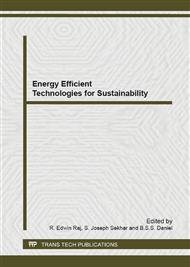[1]
T. Noguchi, S. Togashi, and R. Nakamoto (2000) Short-current pulse based adaptive maximum-power-point tracking for photovoltaic power generation system, IEEE Transactions on Power Electronics, vol. 20, no. 3.
DOI: 10.1109/isie.2000.930504
Google Scholar
[2]
M. A. S. Masoum, H. Dehbonei, and E. F. Fuchs (2002) Theoretical and experimental analyses of photovoltaic systems with voltage and current-based maximum power-point tracking.
DOI: 10.1109/mper.2002.4312477
Google Scholar
[3]
Weidong Xiao, William G. Dunford (2004) A Modified Adaptive Hill Climbing MPPT Method for Photovoltaic Power Systems.
DOI: 10.1109/pesc.2004.1355417
Google Scholar
[4]
Fangrui Liu, Shanxu Duan, Fei Liu, Bangyin Liu, Yong Kang(2008), A Variable Step Size INC MPPT Method for PV Systems, IEEE Transactions on Industrial Electronics , vol. 55, no. 7.
DOI: 10.1109/tie.2008.920550
Google Scholar
[5]
Qiang Mei, Mingwei Shan, Liying Liu, and Josep M. Guerrero (2011) A Novel Improved Variable Step-Size Incremental-Resistance MPPT Method for PV Systems.
DOI: 10.1109/tie.2010.2064275
Google Scholar
[6]
Nicola Femia, Giovanni Petrone, Giovanni Spagnuolo, Massimo Vitelli(2005), Optimization of Perturb and Observe Maximum Power Point Tracking Method, IEEE Transactions on Power Electronics, vol. 20, no. 4.
DOI: 10.1109/tpel.2005.850975
Google Scholar
[7]
G. N. Tiwari and Swapnil Dubey, Fundamentals of Photovoltaic Modules and Their Applications, RSC Energy Series No. 2.
Google Scholar
[8]
J.A. Gow and C.D. Manning Development of a model for photovoltaic arrays suitable for use in simulation studies of solar energy conversion systems, Power Electronics and Variable Speed Drives, Conference Publication No. 429.
DOI: 10.1049/cp:19960890
Google Scholar
[9]
M. G. Villalva, J. R. Gazoli, and E. Ruppert Filho, Comprehensive approach to modeling and simulation of photovoltaic arrays, IEEE Transactions on Power Electronics, vol. 24, pp.1198-1208, (2009).
DOI: 10.1109/tpel.2009.2013862
Google Scholar


